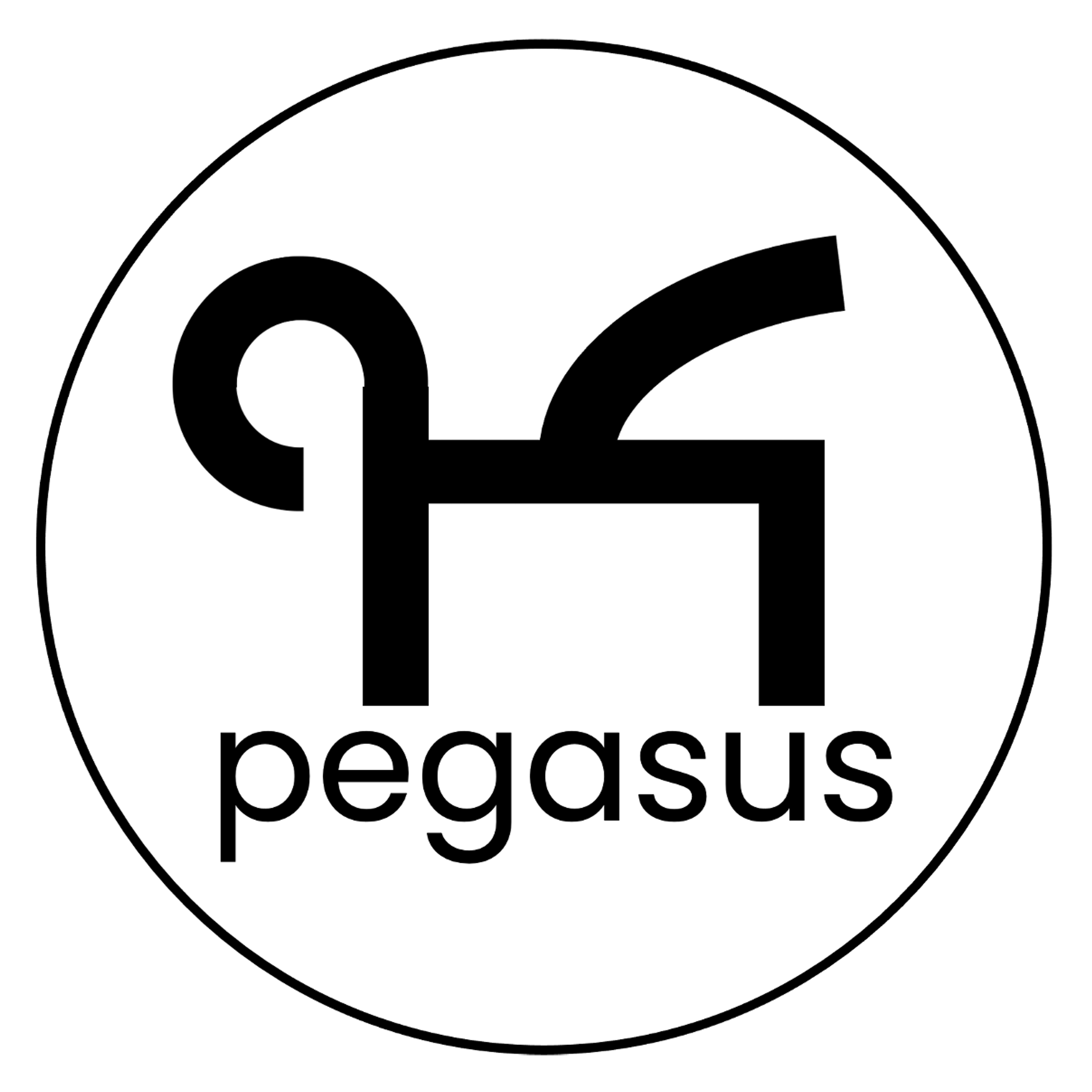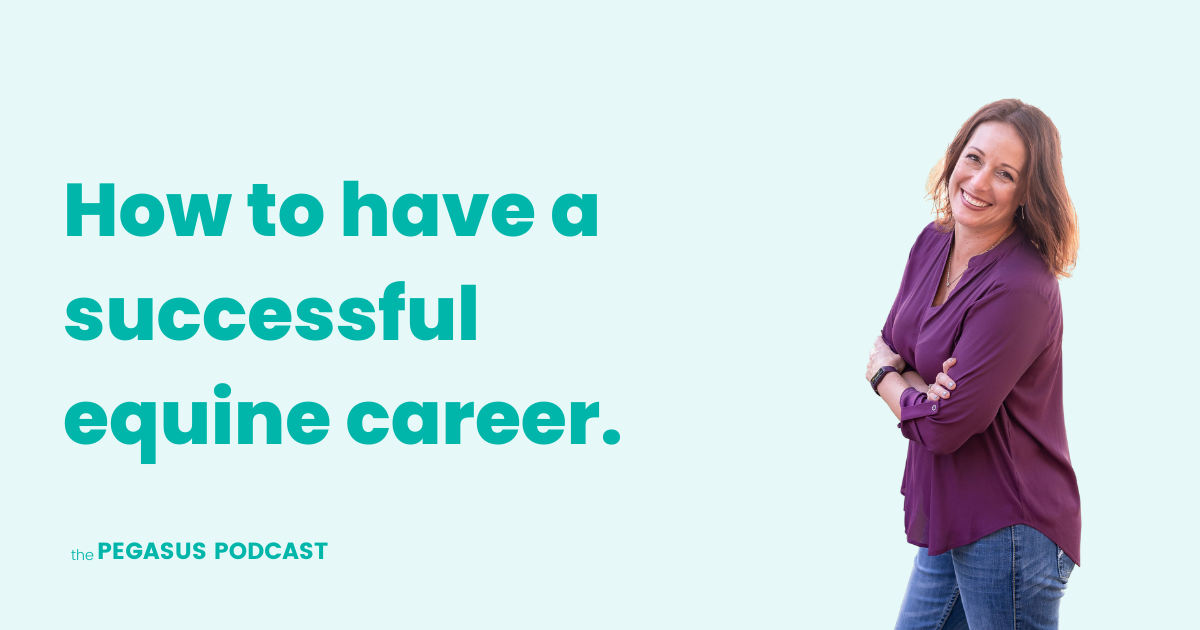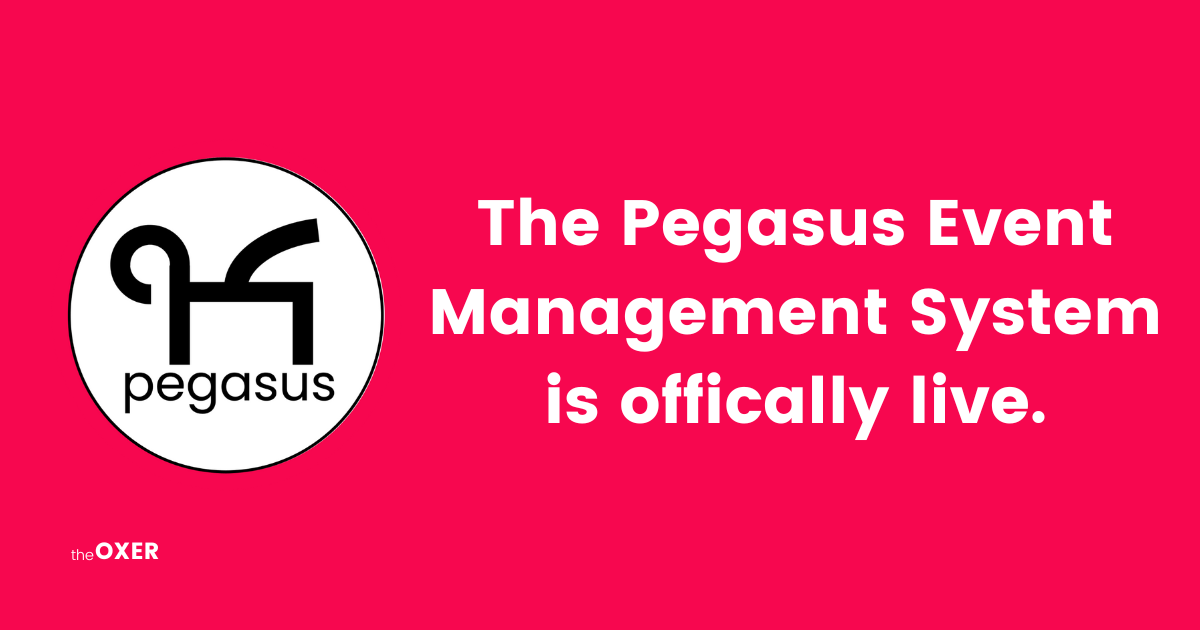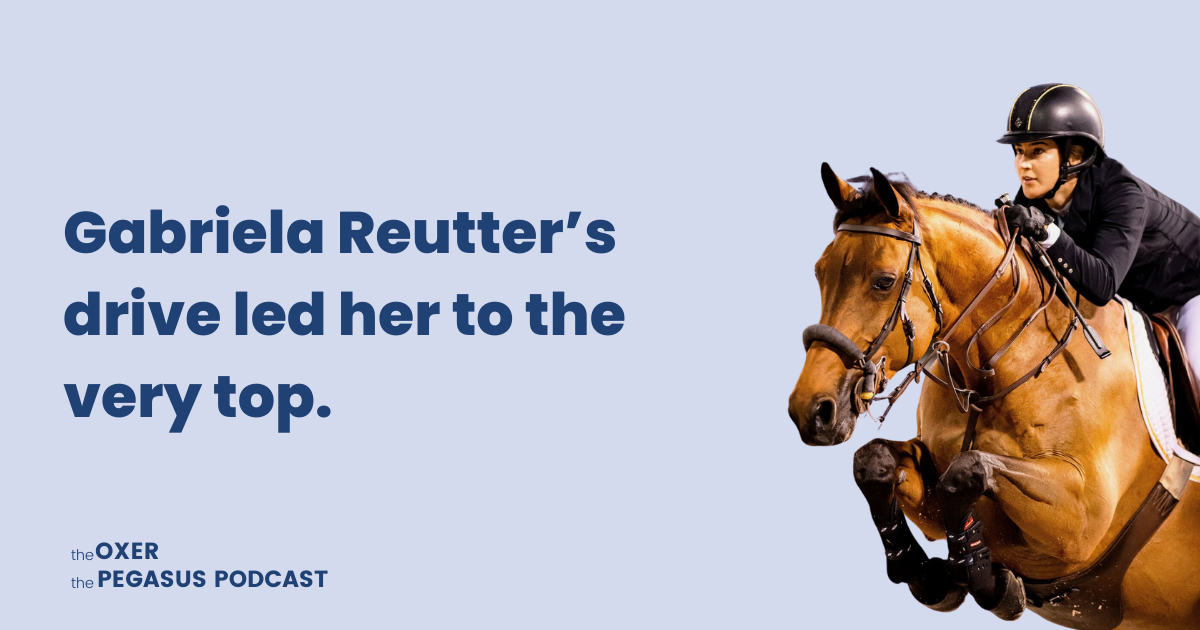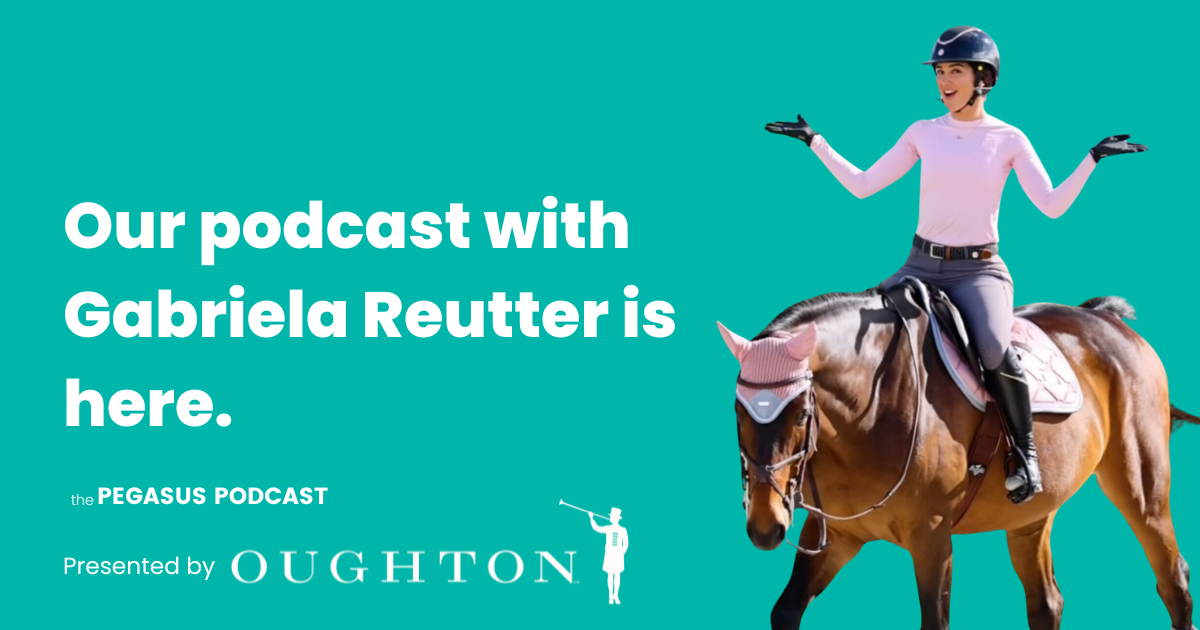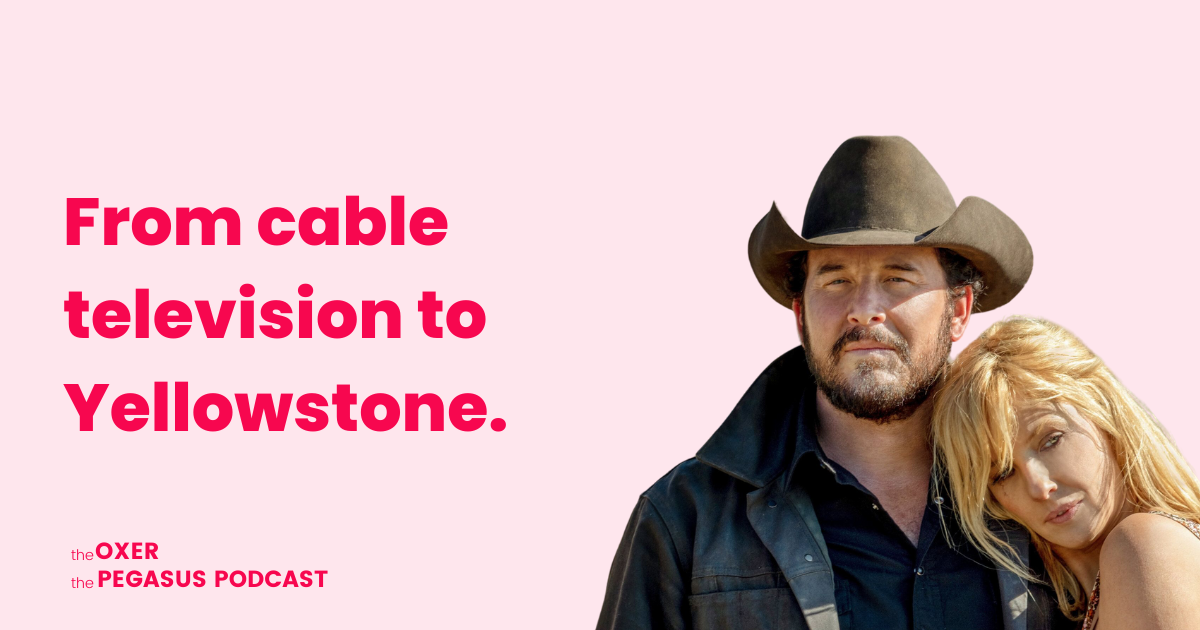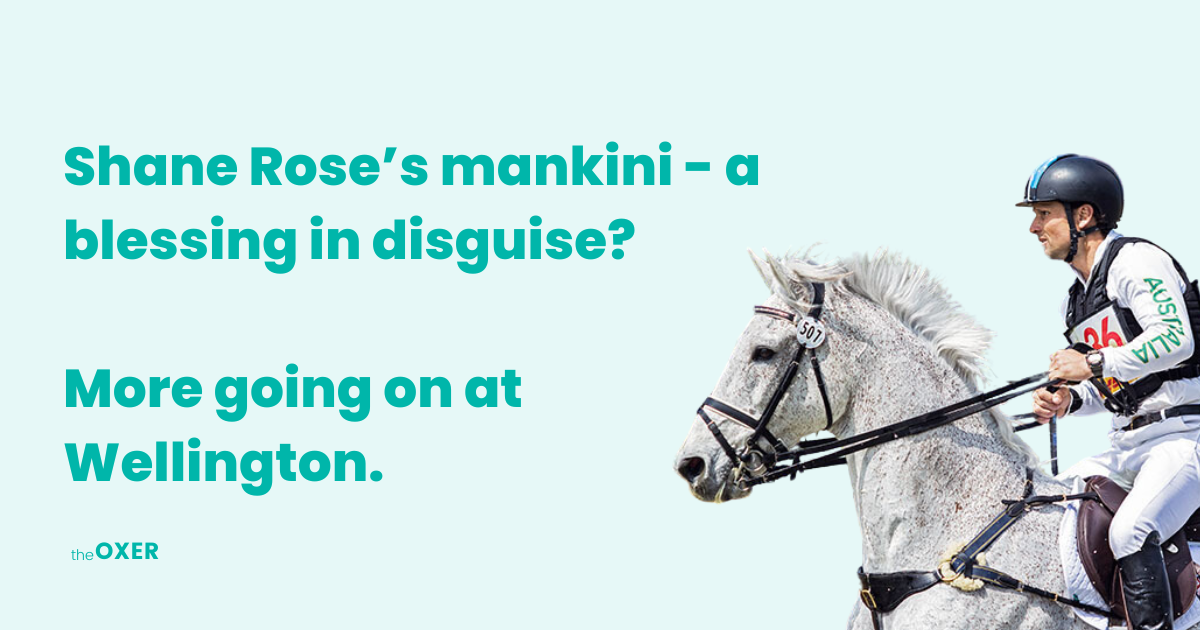By: Clare Mansmann for Pegasus For 673 accepted trainers, the 2019 Retired Racehorse Project Thoroughbred Makeover is now in the rearview. In celebration of the Makeover, Oct. 2-5 at the Kentucky Horse Park, four of those trainers have blogged their journeys, including their triumphs and their heartbreaks, successes and failures. Hoo-RAH! Another TB Makeover has come and gone except it’s never really gone because the process never really ends, much as we humans like markers of time. We’re still training the 2019 horses and we may already have 2020 horses, whether they stay for us to ride or they sell to others, it’s an ongoing process much like a series of novels that keeps introducing new characters and so you don’t have to worry about it going away anytime soon (Hi Thoroughbred Series!). Gosh, we had a great time at the Makeover, as per usual, and I believe that has everything to do with going into it with the right expectations. We love to showcase our horses and our students. We love for our horses to perform as well as they should to this point of their training. I don’t expect them to never have rails because that is not the focus of our training at this point. I don’t expect them to have auto changes because that is not the focus of our training at this point. I don’t expect them to have perfect form over fences because the fences aren’t big enough at this point #amiright. Peter’s hind end is over-powering his front end, but that’s not a bad problem to have. He is clearly not scoped out at 2’6”, and in fact, these jumps are a touch too easy. Photo by Lauren Nicole. Except for Hank, who can jump significantly bigger, but also knows when cameras are on him. (Ellen Dry and Walk Away Slow) Photo by Canterclix. I do expect them to trailer well and unload like gentlemen (and women). I do expect them to stand outside the arena patiently. I expect them to lead well. I expect them to tie at the wash rack. I expect them to behave for the braider. I expect them to stand for mounting. I expect their personalities to shine and for them to display their happiness at a good jump. I do expect them to prick their ears for photos and I do expect them to hop over the fences in front of them. Despite those expectations, if they do or do not meet them, it is up to us. They will or will not depending on how we have taught them, and so if they do or do not, we can learn how to teach them better in the future. I had a wonderful lesson with John Smart recently and he said something that I will paraphrase badly but remember always: “The horse does not have to enjoy doing what we ask in order to do it, but if they do enjoy it, then we have explained it correctly.” Soooo good. Make It Right celebrating big accomplishments for a 4 yrs young whippersnapper! Photo by Michael O’Donnell. I love this. I love when my horse gets appropriately frisky after a big effort. I praise him. I love when their ears and eyes lock on a fence even if we weren’t meaning to jump it. I giggle. I love when a corner or a skinny or a ditch rides no different than a simple table. I love when they continue through a combination in spite of my mistake, because that means I have not made the same mistake over and over, so they still trust me. I love when students make a mistake and laugh. I love when they make a mistake because they are having fun, and not because of fear. I love when we keep the big picture in mind. I don’t love competing. It’s fine, but I don’t love it. I love horses and I love their people. I love learning. I also love snacks. #justsaying Ellen is the best. Photo by Canterclix. We are stewards of these horses, their care, their training, their present and their future, and that fact is always on my mind. A huge amount of resources go into getting a horse transitioned off the track and well started into a new career. The Makeover is just a great goal to keep focus in the first year of the re-career process, but the actual process is more like a 36-month one, and I mention that because I like to make statements that are slightly inflammatory and then explain them. Teaching a racehorse the tools needed to thrive in a new career is like teaching a new language. Sure, Latin languages, so the root is there, but we still have to bridge the gaps. There are tons of nuances that could get overlooked, and you may not know it until later. You may think you know Spanish until you ask for directions and wind up…not where you thought. Rosita actually knows mostly Spanish. We are, essentially, her ESL teachers. (Kim O’Donnell and Roseau). Photo by Canterclix. In addition to the language, they need to develop entirely new muscles, and no matter what you want, that takes time. I have ridden my whole life, so I don’t often get sore in the saddle, but the first time I did jiu jitsu, and thought I could keep up with the squats, I almost died, friends. Died. Literally. And while I can make those dumb decisions, I don’t want that for our horses, so that’s where our gymnastics come into play (flat and jumping), our hills, our walking, all the slow, but consistent, work. It doesn’t happen in the field and it doesn’t come in a bag. Uber cool warhorse, Highly Cynical, and Tom. Photo courtesy of Clare Mansmann. It’s important to us that this gets talked about and understood. We want prospective owners to understand, juniors to understand, adult amateurs to understand, racehorse owners to understand, and trainers
Position Matters: 10 Truths to Live By in the Tack
By Clare Mansmann for Pegasus Photo by Anna Purdy. Horses have no shortage of ways to communicate with us. For the most part, we can tell when they hurt and what hurts, we can tell if they are content, anxious, hungry, thirsty, excited, itchy, hot, cold, how they like to be groomed, and if they need to pee. We, however, have a much more difficult time communicating things to our horse. While we tend to put too many human traits on our horses, we can sometimes use our knowledge of emotions to better relate to them (as long as we don’t take it too far). To do this, we need to have control and insight into our emotions, our reactions to our emotions, and control and awareness of what our body is doing, why it is doing things, and when it is doing it. It all boils down to our body language, which, in the saddle, is our position. Equitation, classically, is functional form, not a competitive discipline. And it does matter, no matter the discipline. Equitation is not ONE position, but it is the balancing of the spine on top of the horse, who just happens to be in motion. Simple, right? As adults, this can be a mind boggling concept. I can’t tell you how often people will come for a riding lesson, ready to work on more advanced moves and practice jumping courses, and we spend two weeks working on posting the trot and how to look where they’re going. Ah, riding is a humbling sport indeed. And so I compiled a list of the Top 10 most humbling, most obvious things about our riding position that makes them no easier to fix, but there is comfort in solidarity. 1. A steady leg is a loose leg. Say what?! Right. The horse is in constant motion. In order to appear still, the rider is actually moving quite a bit, and fluidly. The leg is relaxed and soft. If your leg is braced and locked, it will swing like crazy. If you stay still while the horse is moving, well, what do you think might happen? Furthermore, you don’t hold yourself on the horse with your legs. Frequently someone will say to us, “Oh you must have really strong thighs.” Eh, not really. I spend my whole day trying to use my legs only when I have something to say to the horse, so that they can hear me. If you squeeze all the time, they’ll tune you out like white noise. Your horse is not a ThighMaster. Tip: Start out at the walk… …and let your legs hang down at your sides with not stirrups, completely limp. Notice what happens to your horse. Does he slow down? That’s a sign that your legs may be “talking” more than you’d like. 2. Holding the reins will not save you from losing your balance. Let’s think about it. The reins are a thin piece of leather attached to a piece of metal (or the like) in your horse’s mouth. OR attached to something across their nose (which, fyi, is rather sensitive on a horse). In contrast, the saddle is a much larger, much more stable, piece of equipment. But we humans tend to pull on the reins, pop our butts in the air, and curl into the fetal position. Literally the opposite of what would actually be needed to stay in the saddle. When you’re using the reins to salvage your balance, you’re pretty much hanging by a thread, not to mention interfering with the horse. Tip: Ditch the contact… …put a big ol’ loop in the reins, ride with one hand, ride with no hands, take some lunge lessons, or ride with champagne glasses in each hand. #itworks 3. Your eyes are arguably one of the most important pieces of your position. We know it, but we just don’t always take it as seriously as we should. We either focus on the wrong thing, or we just don’t focus at all, or somewhere in between. Imagine playing tennis and not watching the ball, or driving without watching the road. Furthermore, whilst in the saddle, you are the driver, and thereby responsible for steering, and your eyes play a big part of this. Tip: The next time you’re driving… …or taking a walk, practice drawing an imaginary line with your eyes as you travel, and then take that to your next ride. 4. You should breathe. So simple, right? So why do we forget? Breathing makes a huge difference in your position and in your horse. Constricted breathing can read as anxiety to your body, and next thing you know, you’re riding scared and you don’t know why. Your horse will match your breath, in mind and body. Your body will match your breathing. It’s magical AND science. Tip: Designate “breathe” markers around your ring, field, or course When you see that particular tree or fence board, take a deep breath in AND (here’s the kicker) let it out. Additionally, practice taking a breath and letting it out slowly as you approach your fences and canter transitions. 5. Heels down, but wait, not that far! Do you ever start your ride by shifting back in the saddle and pushing your heels down and in front of you? Some riders do this without conscious thought, and it’s a habit worth noting, and stopping. Early in most of our riding careers, heels down was like THE goal. It was repeated and hollered and we’d even see that one rider with their heels down SO far and try to emulate that and make our coaches so happy. The result? A whole lot of braced legs and tight hips. It’s not that our heels shouldn’t be down, but it’s not all about the heels. It’s actually all about the hips. Weird, right? Our heels should only go down because our leg is so relaxed (see #1) that the heel naturally falls beneath our toes. Pushing the heels
Must Pass PPE
By Clare Mansmann for Pegasus Nothing makes me pause more than this phrase. You’ve seen it, maybe even have said it. It is frequently mentioned in ISO posts, messages, etc, and it is not meant to harm, but some people do not understand the depths of what they are saying. Let’s just at least start with this, with all due respect: there is no such thing as passing or failing a pre-purchase exam (PPE), and many who use the term would even admit that. It’s simply that it’s a quick, easy way to point out that you’re looking for a horse with the least amount of risk possible, aside from the fact that it’s, you know, a horse. It may be speculated that the XYZ condition spotted in a radiograph won’t last at the upper levels, or that the horse will have problems later in life. Maybe. Shoot. There’s a long way between A and XYZ, and a whole lot of other troubles we’ll have to get through, mainly in our own riding, let alone worrying about the ifs, ands, or buts in a crystal ball. People will say they’ve had their heart broken by their last horse, by the last injury, the last colic, the last time they had to say goodbye, the last dream that didn’t come to fruition, and they are desperate not to repeat the experience, hoping that a clean set of radiographs and perfect flexions will protect them. Or they are looking for that horse to take them, or their child to the upper levels of competition, forgetting that the horse that takes you there is so much more than medical records, and rather often makes it in spite of those medical records. And so the pressure on the sellers, the trainers, the owners, the vets, increases, and in turn, the pressure on the horse increases. That is a lot of pressure. A lot. Especially when we are talking about an animal who owes us nothing and whose only goal really is to stand and eat. The process has evolved over time, and an argument stands as to whether that is good or bad, or a little of both. The pre-purchases of yore were fact-finding missions. The physical exam ensured the horse was healthy and ready to work (i.g. no gaping hole in its heart). Findings were presented, and it was up to the prospective buyer to make decisions. That’s a little simplistic, but is generally true, and most people from the days of yore, like myself, would agree. You tended to buy the horse you wanted, and you made it work or you didn’t. It either worked or it didn’t or some degree in between, but that probably had little to do with the PPE. But humans love numbers and measurements and causation and reasons for why anything happens, and that’s not necessarily wrong, but it doesn’t always work. Technology has certainly advanced now. We can see things on a radiograph that we never would have seen before. But it seems that the relationship between advances in veterinary abilities and horsemanship is an inverse one. Horses are looked at as if that day predicts their entire future. Fitness, strength, shoeing, and training are ignored. It’s the same as watching a free jump video and thinking that that is how the horse is going to jump with a rider, or watching a racehorse trot and thinking that’s how it moves. If we are to be stewards of these animals, horsemanship must be paramount, but it is not taught in school or online. Excellent, talented, sweet, suitable, well-trained animals of all varieties are being marked as unsaleable without due process, despite being sound for work. What do we do we all of these horses who are in solid work, doing jobs, proving themselves, but won’t “pass a PPE”? Buyers are scared away from horses needing “maintenance”, despite that not being an actual medical term, envisioning needles, lameness, and vet bills, when actual regular maintenance should come in the form of correct training and nutrition, and yes, horsemanship. When medical attention is necessary, then that care is a wonderful thing, but regular medical intervention should not be the norm and so often does not need to be the first line of defense. Pre-purchase exams today seem designed for horses to “fail”. People have begun using the PPE as the deciding factor in whether or not to purchase a horse, rather than buying a suitable mount. They are relying on and putting pressure on veterinarians to choose their mount, rather than their trainer, and that is not fair, as that is really not what that doctor went to school for. Many vets don’t even ride horses and certainly aren’t trainers or instructors, and it was never their intention to be. There seems to be a disconnect between pre-purchase exams and veterinary care, and I offer this food for thought. If you’re in a PPE situation, and an issue comes up (which it will), ask this to your veterinarian, “If I already owned this horse, and we diagnosed this condition, or found this on a radiograph, what would you say and how could we best take care of this horse to continue our partnership?” The answer may bring a lot more comfort, education, and horsemanship than you think. The solution is not black and white, not an either/or. The pre-purchase exam is a good thing and we encourage them, but it does not remove the responsibility of horsemanship and management from the buyer and trainers surrounding the horse. We need to change our dialogue surrounding the process, be intentional with our words, be honest with ourselves and with others. The PPE does not remove the risk of horse ownership, and it won’t protect our hearts. It’s not even guaranteed to protect our wallets. But there are things that will help, that take time but cost little (I mean, as far as anything in horses goes). There is education,
Making It Big in the Equine Space
Happy Monday partner, On today’s edition of The Pegasus Podcast, we are interviewing Jodi Lynch Findley, host of The Thriving Equine Professional Podcast. After working at Zoetis for a decade, she founded her own brand called JodiSpeaksLife. Through her brand, she gets invited to speak to college students all across the United States. Jodi spotlights the value of real-world experiences and the critical role of networking as she narrates her ascent from a ‘horse girl’ to a professional speaker and mentor. In this episode, we discuss: Why young professionals are hungry for change. How to have a career in the equine space. The economic and political influence of the equine world. And more. Listen on Spotify, Apple Podcasts, or any platform.
The Future of Equestrian Sports is Here
Hi partner, 🦄 We’re excited to announce that the Pegasus Event Management System has officially launched! 🚀 Pegasus is the first modern end-to-end entry and management platform for equestrian events of all disciplines. We make it easier than ever to host, register for, and attend horse shows and clinics. If you’re an event organizer, you’ll easily be able to… Track digital signatures for all exhibitors and staff. Accept online payments and issue refunds. Directly message exhibitors, trainers, owners, and staff. Manage hay and stall purchases and logistics. Schedule and score classes. If you’re a rider or trainer, you now can… Search, browse, and filter events. Create your profile just once = one-click registration for all events. Automate digital signatures. Seamlessly pay and get refunded. Receive notifications for schedule changes or event updates. We also have a major thing coming up: the release of our mobile app! Sign up to use Pegasus on our homepage and if you love what we do, share it with event organizers and be rewarded through our affiliate program. Thanks for being a fan of The Oxer by Pegasus and look out next week for new editions. Cheers to great rides at great events, The Pegasus Team
How Gabriela Reutter’s Persistence Led Her to the Top of Everything Equestrian
Happy Friday partner, On today’s edition of The Oxer by Pegasus, we are covering the most important insights from our Pegasus Podcast episode featuring Gabriela Reutter. Gaby is not only our Pegasus ambassador, but she is also the number one ranked Chilean female Show Jumper and one of the largest equestrian social media influencers, whose content reaches millions of viewers per month. Before we jump into it, are you an event organizer looking to put on your next clinic or horse show? We’re excited to announce that the Pegasus event management system is now live! Pegasus is the first modern horse show entry system that makes it easy to run an event from start to finish. You can accept online entry registrations, receive digital signatures for your event paperwork, as well as manage the logistics, scoring, and scheduling of your event. Run better horse shows with the Pegasus Event Management System at www.thepegasus.app. Gaby’s Career Trajectory in a Nutshell Gaby’s career started in a humble and organic fashion. She was first exposed to horses as a child when her mom took her to see some while on a family vacation. The love for horses soon became an obsession: from petting them once to going to riding classes; to riding every day; to having one horse; then to having multiple horses. Despite Gaby’s success in Chile, the adjustment from her home country to show jumping in the United States proved to be difficult. The Low Junior Show Jumping Classic in the United States was a more challenging course than the Grand Prix in Chile! It just demonstrates how competitive horse sports, especially show jumping, are in the U.S. compared to other countries. The difference between Chile’s show jumping scene versus America’s is massive. Although Chile covers almost all of South America’s Pacific Coast, most of jumping is concentrated in Chile’s capital, Santiago. Because of that, there’s a small number of people in the entire country who compete on a highly competitive level like Gaby. Maybe a handful of FEI events happen annually in Chile. And when they do, they are usually one-star. Gaby got her first taste of America in 2013 when she moved to Wellington as a 16-year-old. She was there for two months and that time turned out to be revelatory for what she needed to do next. Persistent on building her equestrian career in America, Gaby decided she needed to make some changes. The largest of these changes was finding a new trainer. Rather than settling for whomever she could find, Gaby reached out to one of her show jumping idols at the time, Reed Kessler—the youngest show jumper to ever compete in the Olympics. She messaged Reed asking her if she had any recommendations for a trainer. Reed recommended Chris Kappler. Gaby reached out to Chris via a cold email. Now they’ve been working together for over ten years. In many situations, people would’ve gone to Wellington, realized how competitive it was, and had quit. But Gaby didn’t quit: instead, she used it as motivation to become one of the best of the best. Funding a Successful Equestrian Career Funding a long-term career in American horse sports is certainly expensive. According to Gaby, it costs at least $100,000 annually to have a horse and compete at her level. There are two groups of people who are able to do it: riders who already have money or riders who have to fund themselves somehow. Gaby is in the latter of these categories. Gaby has been growing her various income streams, including from brand deals who discover her from social media, to training lessons, to sales horses. Making money from social media wasn’t on her radar until recently. Before the pandemic, Gaby would share rounds and results, maintaining a standard professional account. Then posting a video of combing her horse’s tail went viral, and that was the catalyst for creating even more viral edutainment content. Gaby demonstrates her persistence again with social media. If you go on her Reels page and scroll all the way down, much of the content you’ll see has less than 500 views. Money isn’t the only thing that wins ribbons. As discussed on the podcast, there are a lot of athletes who “pay to play” and do nothing else. they typically have the same patterns: The rely on their horse to do everything. Anything that goes wrong is always the horse’s fault. They hit their natural ceiling. Whereas a true horseperson understands that the horse isn’t a tool: the horse is your partner. In order to win ribbons, you need to view your horse as such. That said, money is what fuels that partnership. In show jumping particularly, how good your horse is matters a lot. Money can make your horse better, by either buying a good horse or investing time—which costs money—to train your horse. Few professional riders are able to connect with and be sponsored by wealthy individuals who pay for their horses and competitions. Most professionals, however, spend the majority of their time training other people’s horses to earn the money they require and and then in their spare time, train their own horse to then go on the road and compete. But the challenge for the latter group to be in the top bracket is that, in order to compete enough to get noticed by sponsors, they need more money to travel and train. As a result, they compete less. They travel less. They get seen less. And then the best riders who have all the money, who have the sponsors, they travel more, they compete more, they get seen more. So they get more of the sponsor’s support. The end result is that the gap gets wider and harder for those who are trying to break into that top tier. It’s wise to think about how to fund your equestrian career if you want to take yourself to the next level. Many thanks to Gaby
How to Be an All-Star Show Jumper and Equestrian Entrepreneur at Once
Happy Wednesday partner, We’ve been looking forward to releasing this episode for a really long time. On today’s edition of The Pegasus Podcast, we are interviewing the one and only Gabriela Reutter. Gabriela is the #1 ranked female Chilean show jumper and is currently based in Wellington. Jumping isn’t the only thing that Gaby is good at, she also has one of the largest social media followings collectively in the equestrian world. When she’s not producing content for millions of people, Gaby works on her content and business, Lumiere Horses, and trains her lucky students. Finally, and here’s the big one, Gaby is an ambassador of Pegasus. She’s helping us digitize the equestrian industry as we know it. In this episode, we discuss: Gaby’s adjustment from Chilean show jumping to jumping at Wellington. How to fund your equestrian career using multiple revenue streams. What it took for her to grow a massive social media following. And more. Listen to this episode on Spotify, Apple, or wherever you listen to your podcasts.
The Epic Story of Running Ride TV
Hey there, partner. This is The Oxer by Pegasus. The newsletter that takes you out of your tack room and into the global equestrian industry. This week, we published our podcast with the founder of Ride TV, Craig Morris. In today’s edition, we’re highlighting key takeaways on running a Western media company. 📺 What It Was Like Running a TV Channel It wasn’t too long ago when we lived in a world in which streaming did not exist. Everyone consumed their video by watching television or by heading to their local Blockbuster to rent a DVD or VHS (ah, millennial nostalgia). These days, anyone from MrBeast to Gabriela Reutter can grab a camera, record themselves, and upload to millions of people in minutes. To get that kind of distribution, Craig and his team at Ride TV had to work much harder. All your [cable] providers are controlled by about eight or nine companies, and all the television channels that are available out there are controlled more or less by eight or nine companies…they control everything and a lot of them control the pipe to your home. Their goal is to be a gatekeeper. It was a tremendously hard uphill battle to start from scratch. Craig Morris Craig ran Ride TV during the time when cable TV was still the primary way to watch television but internet adoption and streaming were growing. Wouldn’t have Ride TV been able to go direct-to-consumer with their own streaming platform? Not exactly. In the cable industry, many agreements contained clauses hindering their ability to offer similar content freely to viewers. It prevented Ride TV from providing free content to the consumer directly via streaming. Why wouldn’t cable companies get in trouble for cartel-like behavior? It’s because there’s about eight or nine companies that they control all of [cable] and put a lot of money into DC. I walked the halls of Congress many, many times and met with a lot of congressional members to try and help change that and to get influence on that other side. It’s a tough road. Like I said, it’s one of those dirty little secrets of the cable industry and it was an uphill battle for us. Craig Morris Ride TV does have a streaming channel, but all of the above possibly hindered their full potential. 🤠 A Yellowstone Moment 5 Years Earlier Would’ve Done Ride TV Wonders The tricky part of running any content business is the business model. For TV channels in the cable era, most of them made money through advertising. The inherent limitations of the equestrian industry as an advertising market became apparent. Existing industry players were already heavily saturated with advertising requests from various associations and events, leaving limited potential for further revenue from them. The primary objective, therefore, was to attract a broader audience by reaching a critical mass of viewers. That would’ve allowed Ride TV to target larger, non-industry advertisers like major corporations, who held the advertising budget necessary to sustain the channel. One significant hurdle is horse sport’s complexity for newcomers. While there are many passionate participants, the general public may lack the basic knowledge to understand the rules and intricacies of competition. Unlike sports like baseball, where even casual viewers can grasp the game’s flow with basic explanation, equestrian sports require a deeper level of understanding to fully engage. This inherent barrier makes it difficult for viewers unfamiliar with the sport to connect with televised competitions. Consequently, simply broadcasting competitions primarily attracts existing fans but fails to captivate a broader audience. This necessitates the creation of content that goes beyond just showcasing competitions. The success of shows like Yellowstone exemplifies this approach. By weaving compelling stories with horses seamlessly integrated into the narrative, viewers become subtly interested in Western equestrian disciplines, even if they weren’t initially drawn to the sport itself. Ride TV didn’t quite capitalize on the current surge of interest in Western sports and lifestyles, similar to the impact of shows like Yellowstone. While Craig and company anticipated this trend and developed shows that resonated with that theme, the lack of wider distribution hindered their ability to fully explore this potential. Thanks a lot to Craig for sparking the conversation and be sure to listen to the full episode on Apple, Spotify, or wherever you listen to your podcasts. Sit your canter,, The Oxer by Pegasus Note: Some of the quotes were edited for concision and clarity.
How to Build a TV Channel for Horse Lovers
Hi there partner, We’re excited to kick it off with our latest episode of The Pegasus Podcast. When the trail shifts unexpectedly beneath your feet, it can lead you to a Hall of Fame career in the cutting horse industry, just ask Craig Morris. We had the pleasure of sitting down with this legend to unravel the tale of his journey from being a student to a cutting horse aficionado; his insights are a treasure trove for anyone enamored with the finesse of equestrian sports. As the hooves thunder and the dust settles, we transition to the world of television—an arena as competitive and enthralling as any equestrian event. We unearth the potential of short-form content and new technologies to engage audiences and share exhilarating previews of upcoming projects designed to make waves in the equestrian world. The discussion encapsulates the passion, strategy, and vision needed to break barriers and ensure the equestrian industry not only trots but gallops boldly into the media spotlight. So, saddle up and join us for a ride that promises to captivate your imagination and fuel your passion for the world of equestrian excellence. In this episode, we discuss: Craig’s journey building Ride TV. The fragmentation of the industry and the hurdles of cable distribution that Ride TV faced. The future of equine content creation. And more. Listen to this episode on Apple, Spotify, or wherever you listen to your podcasts. Before you listen…every eventer knows, a great dressage score requires the right balance of preparation, feel, and focus. It also requires a happy, healthy horse. Zoetis (zoh-EH-tis) has been supporting horses, riders, and veterinarians for more than 70 years. From regenerative medicine devices like Pro-Stride APS, to expert-recommended Quest Gel, Zoetis (zoh-EH-tis) is always by your side in the barn, down the centerline, and everywhere in between. Visit ZoetisEquine.com or follow @Zoetis Equine on Facebook and Instagram to learn more.
Do Stunts Like “Mankini-Gate” Generate Interest in Horse Sports?
Hey there, LinkedIn. This is The Oxer by Pegasus. The newsletter that takes you out of your tack room and into the global equestrian industry. 🐴 Here’s what we’ve got for you today: Shane Rose might’ve helped us all out: This Australian rider’s outfit could’ve generated more interest in the equestrian world.🚧 Board drama at Wellington highlights the venue’s untapped potential: More about this in the second story.🎥 How Jim Greendyk trains for free on Instagram to get more customers: More about that on our writeup in our previous Oxer edition.🎬 Final Foals: Check them out after the second story of this edition. Before we get into it, have you signed up to try out Pegasus’s beta? If not, head to Pegasus, click “get early access,” and sign up today! Let’s get the show on the road 🐎. 👙 Was This Aussie’s Mankini a Blessing in Disguise for the Equestrian Industry? Shane Rose, a prominent Australian eventer and a three-time Olympic medalist, recently found himself at the center of a unique controversy dubbed “mankini-gate.” This unusual choice of attire, far removed from the traditional equestrian dress code, sparked a complaint that led to Equestrian Australia temporarily standing him down, casting uncertainty over his preparation for the upcoming Paris Olympics. Known for his achievements in team eventing, including silver medals at the Beijing 2008 and Tokyo 2020 Olympics, and a bronze at the 2016 Rio Games, Rose’s recent stunt involved wearing a mankini during a competition. The incident, which occurred at an event in New South Wales’ southern highlands, prompted Equestrian Australia to review its minimum dress standards and the education modules for its high-performance program. Equestrian Australia’s chief executive, Darren Gocher, emphasized the body’s duty to address community concerns while announcing that Rose had not breached the code of conduct and was free to resume his Olympic preparations. It’s a common belief that a stunt like Shane Rose’s generates interest. Did Shane Rose wearing a mankini generate more interest in horse sports? A good way to see this is by using Google Trends. Google Trends is a free platform provided by Google to measure how much a keyword was searched for. Google will calculate a score based on keyword search volume from 0 to 100. We took a look at whether or not people are searching for the word “equestrian” more on the date that Shane Rose’s stunt happened to the days following it. The graphic below suggests that in his home country of Australia, interest in “equestrian” rose to prominence on February 19th and a few days afterward when mankini-gate made headlines. Interest in “equestrian” in Australia, according to Google Trends. However, on a global scale, mankini-gate appears to have not affected interest that much. Interest in “equestrian” in Australia, according to Google Trends. But in the United Kingdom, where almost half a million Australians visited last year (and where many Aussies go to live), it appears that mankini-gate might have had a more outsized effect on interest in “equestrian”. Interest in “equestrian” in Australia, according to Google Trends. These stats are telling, especially considering that Google is still the premier platform in the world to search for anything on the web. 🕴️ Ousting of Equestrian Board Members Highlights Wellington’s Development Potential In a recent development in Wellington, the well-known equestrian Mecca, two members of the Equestrian Preserve Committee, Jane Cleveland and Carlos Arellano, were removed from their positions. This action came upon the request of Mark Bellissimo’s Wellington Lifestyle Partners, highlighting a significant tension between development interests and equestrian preservation advocates. The crux of the controversy revolves around Bellissimo’s plans to develop new luxury communities within the 9,000-acre equestrian preserve, known as Wellington North and South, and a proposal for a new showground that would centralize various equestrian events. The attorney for Wellington Lifestyle Partners argued that the outspoken opposition of Cleveland and Arellano against these projects compromised their ability to offer a fair review of the upcoming showground proposal, suggesting a conflict of interest that could potentially lead to a lawsuit over due process concerns. This situation underscores the delicate balance between development and preservation, particularly in a community defined by its equestrian culture. The proposed expansion to Wellington International. The proposed showground aims to consolidate equestrian events into a single campus, featuring amenities like a derby field, barns, and a stadium capable of seating up to 10,000 spectators. If the proposed expansion to Wellington International were to go through, its newest stadium would arguably be the biggest equestrian stadium to spectate at in the U.S., if not the world. This is how the newest stadium compares to some of America’s largest equestrian stadiums. ⌚️ Rolex Stadium (Kentucky Horse Park): 7,338 spectators ⛰️ Tryon International’s indoor arena: 5,000 spectators 🌎 Arena 5 (World Equestrian Center Ocala): 3,400 spectators Keep in mind that this would just add to the current seating capacity Wellington’s overall facilities have. However, the controversy with the board lies not just in the specific details of the project but in the broader implications for the equestrian preserve’s future. It represents an unprecedented intervention by a developer in the composition of a local governance committee, raising questions about the influence of private interests on public decision-making processes. The incident also reflects the ongoing debate within Wellington regarding development within the equestrian preserve, a debate that touches on issues of environmental conservation, community identity, and economic growth. Economic growth has skyrocketed in Palm Beach in recent years The replacements for Cleveland and Arellano, Judith Sloan and Annabelle Garrett, bring their own perspectives to the committee. However, the controversy underscores the tension between the need for development to sustain economic vitality and the desire to preserve the unique character and traditions of the Wellington equestrian community. 🐴 This Week’s Final Foals 📊 American Horse Council is hosting a “datapalooza” to talk about all the insights it learned in the 2023 Economic Impact Study. Use this link to sign up for free online, it’s on March 4th.
